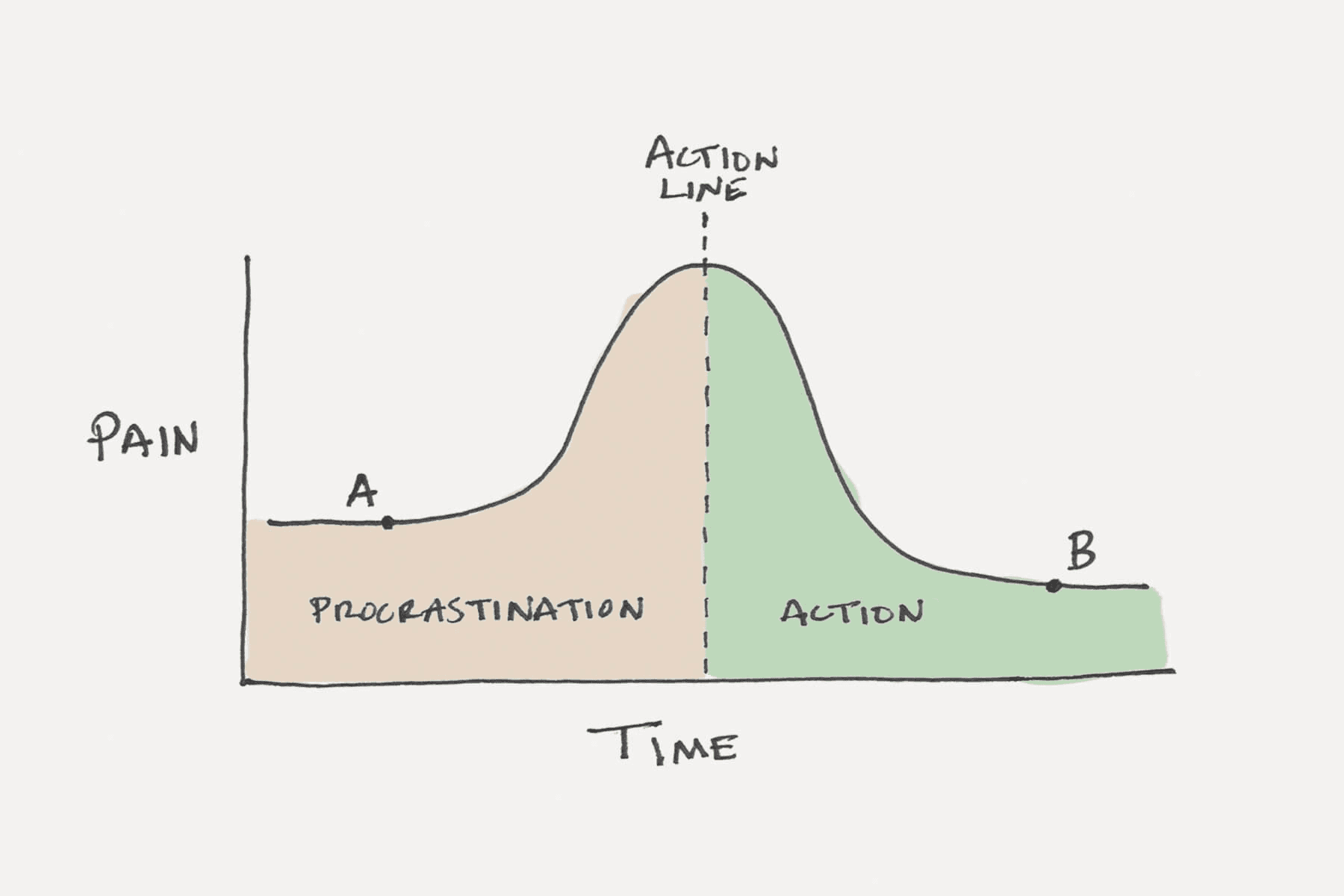Procrastination is never your friend; rather, it is an enemy, an enemy you should deal with before it gets the better of you. It can put your education at risk if you are a student, causing poor quality of work, missed deadlines, and lower grades. Procrastination can equally culminate in financial and employment issues, leading to reduced income, missed opportunities, and lower productivity. Your well-being can also be reduced since procrastination can culminate in increased guilt, lower self-esteem, fatigue, and anxiety. Several social issues can result from procrastination, including isolation, loss of trust, and damaged relationships.

While procrastination is common, some individuals may not know they are experiencing it and, therefore, not know when to start retracing their steps. The tips below will help you determine when you are procrastinating, helping you to know when and where to turn around:
- Low motivation or energy: You do not feel motivated, enthusiastic, or energized to initiate work, even on tasks you initially found interesting or important. You continue putting off work because you "don't feel like it" or “aren't in the right mood.”
- Guilt and frustration: You feel guilty or frustrated about not working on what you know you should do, but cannot seem to take action whatsoever. You say, "I ought to do this," yet do something else and later feel terrible because of it.
- Negative impact on work and personal life: Your procrastination is resulting in poor performance, missed deadlines, stress, or conflicts in your professional and personal life. At work, you fail to meet essential deadlines, or personally delay bill paying or exercise, causing adverse results.
- Procrastination on Multiple Levels: You do not simply delay work-related tasks, but you also procrastinate in areas such as personal projects, household chores, or health care activities. You delay going to the gym, organizing your home, or working on long-overdue personal goals.
- Constant distractions: You get sidetracked, always switching from your work to other activities that call for no concentration, such as entertainment or minor chores. You always switch back and forth from work. You sat down with something, and before you knew it, in a few minutes you opened up the internet or began to watch videos.
- Unnecessary perfectionism: You delay doing something because you're waiting for just the right time to do it, or because you feel everything has to be just so before you can start. You spend too much time planning or researching before you feel you can start the project.
- Relying on last-minute pressure: You always wait until the last-minute pressure of a near deadline gets you started. You pull an all-nighter or work feverishly right up until the deadline to complete the work that you had plenty of time to do.
- Overwhelmed or avoidant: A task is too overwhelming or thinking of it will be so stressful that you avoid starting or restarting the task. You won't check your email or calendar because you don't want to see what needs to be done.
In this informative piece, we will enlighten the readers on how to overcome procrastination.
Key benefits of overcoming procrastination
- Overcoming procrastination will bring complete peace of mind, helping you to feel capable and strong.
- Good productivity hacks will also increase your productivity, ensuring that you waste less time and put in more each day, resulting in little or no backlogs.
- You can now manage your time better and end up attending to most of your important tasks before the end of each day.

Comparison chart: 7 effective strategies for staying on track to beat procrastination
Strategies | Key features | Pros | Cons |
|
|
| |
|
|
| |
|
|
| |
|
|
| |
|
|
| |
|
|
| |
|
|
|
7 Effective Strategies for Staying on Track to Beat Procrastination
1. The Pomodoro Technique
Key Features:
- 25-minute work intervals
- 5-minute breaks
- Longer break after several cycles
Pros:
- Enhances focus and concentration.
- Reduces fatigue due to regular breaks
- Inculcates persistent effort.
Cons:
- Deep work is interrupted
- Rigid timing may not suit everybody
- Can feel rushed for more complex tasks.
2. Time Blocking
Key Features:
- Fixed time blocks allocated for tasks
- Structured daily or weekly schedule
- Plan on what particular task to handle in each block
Pros
- Clear boundaries between tasks
- More productive since one does very little to no multitasking
- Keeps big projects manageable long-term
Cons:
- Can be unyielding, hence difficult to adjust to changes
- Overscheduling leads to burnout
- Requires regular cleaning
3. Eisenhower Matrix
Key Features:
- Divide tasks into categories using urgency and importance, making it one of the best productivity hacks
- Quadrant-based decision-making tool
- Focus on the highest priority tasks
Pros:
- Prioritize better with this technique
- Eliminate insignificant tasks to avoid an overwhelming workload
- Avoid squandering time on less important tasks
Cons:
- It takes lots of time to categorize tasks on a regular basis
- May include lesser tasks which are also necessary
- Can result in indecisiveness due to equal ranking
4. "Eat That Frog"
Key Features:
- Do the hardest or most important task first
- Morning productivity boost
- Gives motivation by accomplishment
Pros:
- Eliminate procrastination on major tasks
- Gain momentum early in the day
- Reduces stress by attacking large challenges first
Cons:
- Difficult to confront difficult tasks at the beginning
- May delay smaller yet important tasks
- Can lead to early exhaustion in the day

5. Two-Minute Rule
Key Features:
- Immediate action on tasks that can be done within less than 2 minutes
- Deals with emails, small chores, or short tasks
- Quick action activity tool
Pros:
- Eliminates petty tasks at once
- Builds momentum for huge tasks
- Reduces backlogs for tasks
Cons:
- May lead to a diversion from larger goals
- Can break focused work on big tasks
- Cannot apply to complex pieces of work
6. Task Segmentation
Key Features:
- Reducing big tasks into smaller steps
- Building an approach, step-by-step, on completion
- Focused on steady progress
Pros:
- Large tasks are less overwhelming
- It provides visible progress with increased motivation
- Starting is easier when tasks are less daunting
Cons:
- Overplanning takes up precious time
- Might stress the steps and not bigger objectives
- Risk of losing the big picture
7. Accountability Partner
Key Features:
- Partner-based accountability system
- Regular check-in with progress
- External pressure for deadlines
Pros:
- Increased motivation through social pressure
- Adds a layer of accountability
- Supportive and give feedback
Cons:
- This is mainly not easy to find a good partner
- Sometimes, it may lead you towards relying on others
- It can sometimes be problematic to schedule check-ins.

FAQs
Q: What is "Eat That Frog," and why does it work?
A: "Eat That Frog" simply means taking care of your most complicated or big task right from the beginning of the day. Otherwise, start with the hardest task so that the rest of your day will seem much easier compared with it. It reduces procrastination and instills momentum; it also reduces stress because it will be done early. Hard tasks are hard to start during morning hours; you can procrastinate on easier tasks, which are less important. Such tasks can also be exhausting early in the day.
Q: What is the Two-Minute Rule, and how does this rule combat procrastination?
A: The Two-Minute Rule is based on the principle of not procrastinating on anything that can be done within two minutes or less. This system works out most of the little tasks quickly and prevents the small to-dos from building up. You should get rid of tiny tasks efficiently since it will help you build momentum and reduce the task backlog. It can distract you from more important tasks with greater significance. Constant breaks can equally prevent getting into a flow not suited for complex tasks.
Q: How does breaking tasks down into small steps aid procrastination?
A: This approach necessitates breaking down the major and big tasks into smaller, manageable portions. It helps in the sense that the task will not be overgrown and difficult to do since it is trimmed into small-size portions which can encourage starting and getting into action. It reduces the feeling of being overwhelmed. Progress of work is also more visible and hence easy to get started. It can culminate in over-planning; causing you to focus on minor steps while losing track of the big picture.
Q: How does an Accountability Partner help beat procrastination?
A: An accountability partner is a person who will keep you on your toes and help you stay committed to your goals. You should regularly check in with this person regarding your progress, challenges, and upcoming tasks. The person can motivate you even when you are under social pressure. This can result in external accountability, and provide support and feedback received. Finding the right partner might be difficult. This approach risks dependence on somebody else to get motivated, and doing the regular check-in may be difficult at times.





